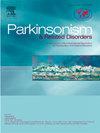Boostering motor imagery processing to improve gait in patients with Parkinson disease and freezing of gait: A pilot study
IF 3.1
3区 医学
Q2 CLINICAL NEUROLOGY
引用次数: 0
Abstract
Background
Given that patients with Parkinson's Disease (PD) and Freezing of Gait (FoG) may lack the cognitive resources necessary to activate the motor imagery (MI) process, investigating how to boost MI vividness and accuracy could be a valuable therapeutic strategy in MI Practice (MIP).
Objective
We aim to evaluate the priming effect of visual, or auditory, or attentional stimuli in enhancing MI ability by using quantitative data on gait and turning performance.
Methods
Nineteen PD participants with FoG underwent four one-week sessions of MIP, with pre and post clinical assessments. Each session included MI alone or one of three booster MI tasks (Attentional, Action observation, or Auditory) before imagining and executing walking straight and performing a 180° turn. Gait and turning performances were evaluated using six inertial sensors before and after each session.
Results
Our findings showed that both MI and boosted MI induced similar improvement in gait (speed and stride length) and 180° (step number and velocity) and 360° turning (velocity, angle) parameters compared to baseline. When differences among “booster” tasks were analyzed, results showed that Auditory and Attentional boosted MI were superior to MI alone in some gait and turning parameters. At the end of the 4 sessions, MI ability measured by means of Kinesthetic and Visual Imagery Questionnaire and Gait Imagery Questionnaire and FoG symptoms were also improved.
Conclusion
Our preliminary results suggest that boosting MI is a feasible strategy for enhancing MI ability and addressing FoG symptoms. Auditory and Attentional conditions appear to enhance the priming effect of MI on gait and turning performance more effectively.
促进运动想象处理,改善帕金森病和步态冻结患者的步态:试点研究
背景:鉴于帕金森病(PD)和步态冻结(FoG)患者可能缺乏激活运动想象(MI)过程所需的认知资源,研究如何提高运动想象的生动性和准确性可能是运动想象练习(MIP)中一项有价值的治疗策略:我们旨在通过步态和转弯表现的定量数据,评估视觉、听觉或注意力刺激对增强运动想象能力的引物效应:19名患有FoG的帕金森病患者接受了四次为期一周的MIP训练,并进行了前后临床评估。每个疗程都包括单独的多元智能或三项辅助多元智能任务(注意力、动作观察或听觉)之一,然后想象并执行直走和 180° 转体。每次训练前后都会使用六个惯性传感器对步态和转弯表现进行评估:结果:我们的研究结果表明,与基线相比,步态训练和增强步态训练在步态(速度和步长)、180°(步数和速度)和360°转弯(速度和角度)参数方面都有类似的改善。在分析 "助推 "任务之间的差异时,结果显示在某些步态和转弯参数方面,听觉和注意力助推混合训练优于单独的混合训练。在 4 个疗程结束后,通过运动学和视觉意象问卷、步态意象问卷测量的多元智能能力以及 FoG 症状也得到了改善:我们的初步研究结果表明,增强多元智能是提高多元智能能力和解决 FoG 症状的可行策略。听觉和注意力条件似乎能更有效地增强多元智能对步态和转身表现的启动效应。
本文章由计算机程序翻译,如有差异,请以英文原文为准。
求助全文
约1分钟内获得全文
求助全文
来源期刊

Parkinsonism & related disorders
医学-临床神经学
CiteScore
6.20
自引率
4.90%
发文量
292
审稿时长
39 days
期刊介绍:
Parkinsonism & Related Disorders publishes the results of basic and clinical research contributing to the understanding, diagnosis and treatment of all neurodegenerative syndromes in which Parkinsonism, Essential Tremor or related movement disorders may be a feature. Regular features will include: Review Articles, Point of View articles, Full-length Articles, Short Communications, Case Reports and Letter to the Editor.
 求助内容:
求助内容: 应助结果提醒方式:
应助结果提醒方式:


